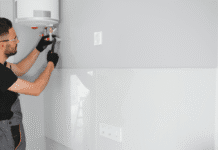Whether you’re a seasoned DIY enthusiast or a first-time home decorator, preparing your walls for a fresh coat of paint is a crucial step towards achieving a professional-looking finish. As a painter in North London, I’ve learned that proper wall preparation can make all the difference between a flawless, long-lasting paint job and one that quickly loses its luster. In this comprehensive guide, I’ll share my top tips and tricks to help you get your walls ready for a seamless painting experience.
Table of Contents
Cleaning the Walls
Before you even think about picking up a paintbrush, it’s essential to ensure your walls are clean and free of any dirt, grease, or debris. This step may seem tedious, but it’s crucial for ensuring your new paint adheres properly and looks its absolute best. Start by giving the walls a thorough wipe-down using a damp cloth or a mild cleaning solution. Pay special attention to areas around light switches, door frames, and baseboards, as these tend to accumulate more grime. For tougher stains, you may need to use a slightly more abrasive cleaner, but be sure to test it in an inconspicuous area first.
Once the walls are clean, take the time to thoroughly dry them with a clean, lint-free cloth. Rushing through this step can lead to unsightly bubbling or peeling in the long run, so be patient and make sure the surface is completely dry before moving on.
Repairing Cracks and Holes
After cleaning, closely inspect your walls for any cracks, holes, or other imperfections that need to be addressed. These blemishes can significantly detract from the final look of your paint job, so it’s essential to take the time to properly repair them.
For small cracks or nail holes, a simple spackling compound or wall filler should do the trick. Apply the compound with a putty knife, making sure to smooth it out flush with the surrounding surface. Once dry, lightly sand the area to ensure a seamless transition. Larger holes or cracks may require a more extensive repair process, such as cutting out and replacing drywall sections. If you’re unsure about tackling these more complex issues, it’s always best to consult with a professional painter in North London or a home improvement specialist.
Proper wall preparation, including repairing any imperfections, is the foundation for a flawless paint job. Taking the time to address these issues upfront will save you a lot of headaches down the line.
Sanding and Smoothing
With the walls clean and any cracks or holes repaired, it’s time to focus on creating a smooth, even surface for your new paint. Sanding is a crucial step in this process, as it helps to remove any remaining bumps, ridges, or uneven textures that could mar the final appearance.
Start with a coarse-grit sandpaper, such as 80-100 grit, to tackle any stubborn imperfections or high spots. Work in small, circular motions, applying gentle pressure to avoid accidentally gouging the wall. Once you’ve smoothed out the major issues, switch to a finer 120-150 grit sandpaper to refine the surface and ensure a silky-smooth finish.
Be sure to thoroughly wipe away any dust or debris after sanding, as these particles can interfere with the paint adhesion and leave an uneven, textured appearance. You may also want to consider using a damp cloth to lightly dampen the walls, as this can help to further smooth the surface and remove any lingering particles.
Investing the time and effort into properly sanding and smoothing your walls will pay dividends when it comes to the final paint application. A flawless, professional-looking finish starts with a meticulously prepared surface.
Priming the Walls
With the walls clean, repaired, and smoothed, it’s time to move on to the priming stage. Applying a high-quality primer not only helps the paint adhere better, but it can also enhance the finished look and even improve the coverage of your topcoat.
When selecting a primer, it’s important to choose one that’s compatible with the type of paint you’ll be using. For most standard interior wall paints, a latex-based primer is a safe bet. However, if you’re working with oil-based paints or dealing with stains or other difficult surfaces, you may need to opt for an oil-based or specialty primer.
Regardless of the primer you choose, be sure to follow the manufacturer’s instructions carefully. Apply the primer in thin, even coats, allowing it to fully dry between applications. This step is especially crucial if you’re covering up a drastically different color, as the primer will help to create a more uniform base for your new paint.
Priming your walls may seem like an extra step, but it’s an essential part of the preparation process. Taking the time to properly prime your surfaces will ensure a long-lasting, professional-quality finish that’s sure to impress any professional painter.
Protecting Surfaces
As you near the final stages of your wall preparation, it’s crucial to take the necessary steps to protect any surfaces or areas that you don’t want the paint to touch. This includes trim, baseboards, floors, and even nearby furniture or décor.
Applying painter’s tape along the edges of trim and molding is a simple and effective way to create a clean, crisp paint line. Be sure to press the tape down firmly to prevent any paint from seeping underneath. For floors and other surfaces, use drop cloths or plastic sheeting to catch any drips or overspray.
Taking the time to properly mask and cover these areas may seem like a hassle, but it can save you a significant amount of time and effort in the long run. Trying to clean up errant paint splashes or touch up sloppy edges can be a real headache, so it’s always better to err on the side of caution and protect your surfaces thoroughly.
Remember, a flawless paint job is all about attention to detail. By meticulously preparing and protecting your walls, you’re setting the stage for a professional-looking finish that will make any painter proud.
Finishing Touches
With all the preparatory steps complete, you’re now ready to apply your new paint and enjoy the stunning results. But before you get started, take a moment to do one final sweep of the room, ensuring everything is properly covered and protected.
Once you’re confident that your surfaces are ready, it’s time to crack open that fresh can of paint and get to work. Apply the paint in thin, even coats, following the manufacturer’s recommended drying time between applications. Pay close attention to edges and corners, using a high-quality angled brush to achieve a seamless look.
As you work, be mindful of maintaining a wet edge to prevent visible lap marks or overlaps. And don’t forget to take breaks and give your arms a rest – painting can be surprisingly physically demanding!
Finally, once the last coat has dried, take a step back and admire your handiwork. The time and effort you’ve invested in properly preparing your walls will be evident in the flawless, long-lasting finish. Whether you’re a seasoned DIY enthusiast or a first-time painter, following these steps will ensure a professional-quality result that any painter would be proud of.
Apart from that, if you are interested to know about Painting Projects for an Aesthetically Pleasing Interior then visit our Home Improvement category.
















